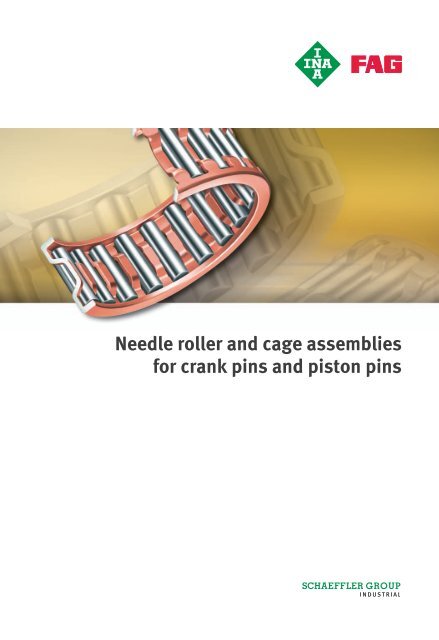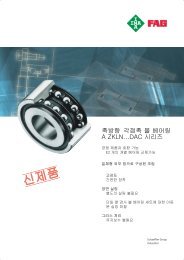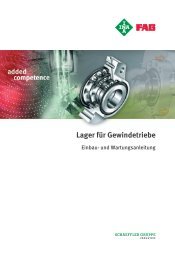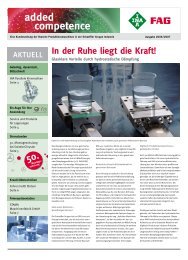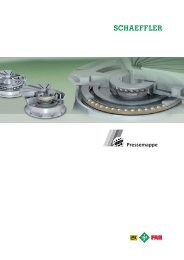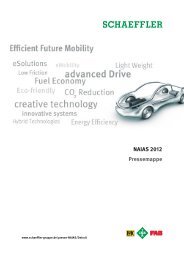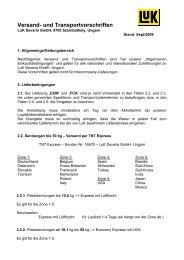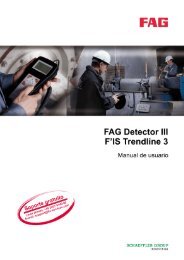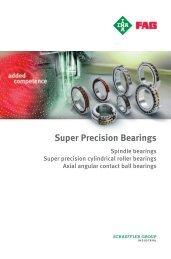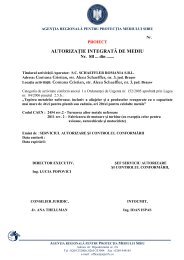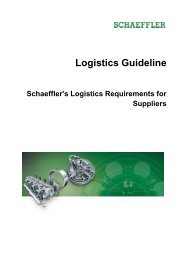Download (PDF, 641.46 kB) - Schaeffler Group
Download (PDF, 641.46 kB) - Schaeffler Group
Download (PDF, 641.46 kB) - Schaeffler Group
Create successful ePaper yourself
Turn your PDF publications into a flip-book with our unique Google optimized e-Paper software.
Needle roller and cage assemblies<br />
for crank pins and piston pins
Product overview Needle roller and cage assemblies<br />
for crank pins and piston pins ................................................... 2<br />
Features Needle roller and cage assemblies for crank pins ...................... 3<br />
Needle roller and cage assemblies for piston pins..................... 3<br />
Design and<br />
safety guidelines<br />
Guidance of the connecting rod................................................. 4<br />
Design of adjacent parts............................................................ 5<br />
Preferred enveloping circle diameter<br />
of needle roller and cage assemblies......................................... 5<br />
Accuracy ................................................................................................. 6<br />
Radial internal clearance ........................................................... 7<br />
Sort plan for crank pin bearing arrangements ............................ 8<br />
Sort plan for piston pin bearing arrangements........................... 8<br />
Special designs ................................................................................................. 9<br />
Ordering example and<br />
ordering designation<br />
Needle roller and cage assemblies<br />
for crank pins and piston pins<br />
................................................................................................. 9<br />
Dimension tables Needle roller and cage assemblies for crank pins ...................... 10<br />
Needle roller and cage assemblies for piston pins..................... 11<br />
Appendix Calculation of rolling bearings in crank machines...................... 12<br />
Datasheets, functional diagram................................................. 12<br />
Datasheet · Needle roller and cage assemblies<br />
for crank pins and piston pins ................................................... 13<br />
Datasheet · Functional diagram and examples of load cases ..... 15<br />
<strong>Schaeffler</strong> <strong>Group</strong> Industrial TPI 94 1
Product overview Needle roller and cage assemblies<br />
for crank pins and piston pins<br />
For crank pins KZK<br />
For piston pins KBK<br />
2 TPI 94 <strong>Schaeffler</strong> <strong>Group</strong> Industrial<br />
102 153a<br />
102 154
Features Needle roller and cage assemblies for connecting rod bearing<br />
arrangements are used in the crank mechanisms of 2 and 4 stroke<br />
engines as well as in compressors for supporting crank pins and<br />
piston pins. They consist of cages equipped with needle rollers,<br />
support high centrifugal and acceleration forces and are suitable<br />
for high speeds.<br />
They require very little radial space since the radial section height<br />
only corresponds to the diameter of the needle rollers. They give<br />
bearing arrangements with high runout accuracy which is, however,<br />
influenced by the geometrical accuracy of the raceways. The radial<br />
internal clearance is dependent on the needle roller sort as well as<br />
the shaft and housing tolerances and can be adjusted by means of<br />
the needle roller sort.<br />
The raceways must be hardened, ground and honed.<br />
Needle roller and<br />
cage assemblies<br />
for crank pins<br />
Needle roller and<br />
cage assemblies<br />
for piston pins<br />
Needle roller and cage assemblies<br />
for crank pins and piston pins<br />
Needle roller and cage assemblies for crank pins are externally<br />
guided, which means that the connecting rod bore guides the cage<br />
radially with little clearance. The radial movement of the cage in<br />
relation to the connecting rod bore and the rolling elements is as<br />
small as possible.<br />
The cages are made from quenched and tempered steel, undergo<br />
little wear, have high strength and their large guidance surfaces<br />
are designed for optimum lubrication.<br />
Needle roller and cage assemblies for piston pins are internally<br />
guided, which means that the piston pin guides the cage radially<br />
with little clearance. Due to their small radial internal clearance,<br />
tilting of the connecting rod is reduced to a minimum.<br />
They support high frequency oscillating loads and are available<br />
for the majority of piston pin diameters in various widths –<br />
in accordance with the piston boss spacing.<br />
The low-wear steel cages are case hardened or quenched and<br />
tempered and have high strength.<br />
Further information Further information on needle roller and cage assemblies is given<br />
in Catalogue HR 1, Rolling Bearings.<br />
<strong>Schaeffler</strong> <strong>Group</strong> Industrial TPI 94 3
Design and<br />
safety guidelines<br />
Guidance<br />
of the connecting rod<br />
Needle roller and cage assemblies<br />
for crank pins and piston pins<br />
Depending on which parts of the crank mechanism are guided<br />
laterally by the connecting rod, a distinction is drawn between<br />
crank end guidance and piston end guidance.<br />
Crank end guidance The connecting rod and needle roller and cage assembly KZK are<br />
guided axially between the crank webs, Figure 1. The connecting rod<br />
eye at the crank end must have lubrication pockets and slots to<br />
allow the supply of lubricant.<br />
The KBK is guided axially between the piston boss abutment<br />
surfaces. Free lateral movement of the connecting rod between<br />
the piston bosses.<br />
Figure 1<br />
Crank end guidance –<br />
lateral guidance<br />
of the connecting rod 102 157<br />
Piston end guidance The connecting rod and needle roller and cage assembly KBK are<br />
guided axially between the piston bosses, Figure 2. As a result,<br />
wider piston pin bearing arrangements and longer pistons are<br />
generally necessary.<br />
In order to ensure free axial movement of the connecting rod,<br />
the crank webs must be turned to give sufficient clearance.<br />
In order to ensure good radial guidance of the needle roller and<br />
cage assembly KZK, the large connecting rod eye must be matched<br />
to the width of the needle roller and cage assembly KZK.<br />
Figure 2<br />
Piston end guidance –<br />
lateral guidance<br />
of the connecting rod 102 158<br />
4 TPI 94 <strong>Schaeffler</strong> <strong>Group</strong> Industrial
Design of adjacent parts The bores and pins for the needle roller and cage assemblies must<br />
be produced as rolling bearing raceways. A roughness Rz1(Ra0,2) must be ensured.<br />
The rolling bearing raceways, thrust surfaces and thrust washers<br />
must be as follows:<br />
■ case hardened to at least 0,5 mm deep;<br />
a surface hardness of at least 700 HV must be ensured.<br />
■ The lateral thrust surfaces should be precision machined<br />
(Ra2 recommended) and wear resistant; thrust washers should<br />
be fitted if necessary.<br />
For lubrication of the needle roller and cage assemblies, holes or<br />
lubrication pockets should be provided, with additional lubrication<br />
slots for the crank end guidance.<br />
Materials should be selected in accordance with the following table.<br />
Proven materials for adjacent parts Adjacent part Material<br />
Connecting rod 16MnCr5, 15CrNi6<br />
Crank pin 15Cr3, 17Cr3, 15CrNi6<br />
Piston pin Ck15, 15Cr3, 17Cr3<br />
Preferred enveloping circle<br />
diameter of needle roller and<br />
cage assemblies<br />
Proven enveloping circle diameters<br />
for 2 stroke engines<br />
The dimensions of the needle roller and cage assemblies KZK and<br />
KBK are determined by factors including the capacity of the cylinder.<br />
The table below for 2 stroke engines shows the preferred enveloping<br />
circle diameters F w of needle roller and cage assemblies for proven<br />
diameters of crank pins and piston pins. Other enveloping circle<br />
diameters may be available if sufficient quantities are required.<br />
In order to design needle roller and cage assemblies for a specific<br />
engine, the technical data of the engine must be taken into<br />
consideration. The datasheets, page 13 to page 15, must be<br />
completed and returned to us.<br />
Capacity per cylinder Enveloping circle for<br />
KZK KBK<br />
cm3 Fw mm<br />
Fw mm<br />
incl. 35 8 to 14 8 to 12<br />
over 35 incl. 50 12 to 16 10 to 12<br />
over 50 incl. 100 16 to 20 12 to 14<br />
over 100 incl. 150 18 to 22 14 to 16<br />
over 150 incl. 200 22 to 24 16 to 18<br />
over 200 incl. 300 24 to 28 18 to 22<br />
over 300 28 min. 20 min.<br />
Caution! In order to determine the crank pin diameter for 4 stroke engines,<br />
the technical data of the engine are required, see datasheets,<br />
page 13 to page 15.<br />
<strong>Schaeffler</strong> <strong>Group</strong> Industrial TPI 94 5
Permissible geometrical tolerances<br />
for crank pin bearing arrangements<br />
Permissible geometrical tolerances<br />
for piston pin bearing<br />
arrangements<br />
Needle roller and cage assemblies<br />
for crank pins and piston pins<br />
Accuracy The geometrical tolerances of the raceways must be in accordance<br />
with the tables and Figure 3 and Figure 4.<br />
� Crank end guidance<br />
Figure 3<br />
Geometrical tolerances<br />
for crank pin bearing arrangements<br />
� Piston end guidance<br />
Figure 4<br />
Geometrical tolerances<br />
for piston pin bearing arrangements<br />
Nominal<br />
dimension<br />
Deviation for<br />
F1 F1 E1 over<br />
mm<br />
incl.<br />
mm<br />
Parallelism<br />
�m<br />
Roundness<br />
�m<br />
Parallelism<br />
�m<br />
8 14 1 1 2 1<br />
14 18 1 1 2 1<br />
18 22 1 2 3 2<br />
22 25 2 2 3 2<br />
25 30 2 2 4 2<br />
30 – 2 2 4 3<br />
H6<br />
1 E1(G6) A B<br />
Nominal<br />
dimension<br />
Deviation for<br />
F2 F2 E2 over<br />
mm<br />
incl.<br />
mm<br />
Parallelism<br />
�m<br />
Roundness<br />
�m<br />
0,04/100 C<br />
Roundness<br />
�m<br />
6 TPI 94 <strong>Schaeffler</strong> <strong>Group</strong> Industrial<br />
C<br />
F 1<br />
0,04/100 AB<br />
Parallelism<br />
�m<br />
8 14 1 1 2 1<br />
14 18 1 1 2 1<br />
18 24 2 2 3 2<br />
2<br />
E2 K6<br />
F2<br />
A B<br />
C<br />
0,04/100 C<br />
0,04/100 AB<br />
Roundness<br />
�m<br />
010 033<br />
010 059
Radial internal clearance The radial internal clearance can be determined by means of<br />
the needle roller sort, see table Sort plan for crank pin and piston<br />
pin bearing arrangements, page 8. For simplification, the mean<br />
values of the needle roller sorts can be used.<br />
Example of determination of the radial internal clearance using<br />
the mean value of the needle roller sort:<br />
■ Needle roller sort 0 –2, mean value –1.<br />
For crank pin bearing arrangements The radial internal clearance is dependent on the speed, rigidity and<br />
accuracy of the crankshaft parts.<br />
Caution! Minimum values for the radial internal clearance according to the<br />
table Radial internal clearance – minimum values to be achieved.<br />
Do not exceed the tolerance range of 0,015 mm.<br />
For very high speeds (for example in race engines),<br />
please contact us.<br />
For piston pin bearing<br />
arrangements<br />
The radial internal clearance must be at least 0,002 mm and must<br />
not exceed 0,012 mm.<br />
<strong>Schaeffler</strong> <strong>Group</strong> Industrial TPI 94 7
Sort plan<br />
for crank pin bearing<br />
arrangements<br />
Sort plan<br />
for crank pin bearing<br />
arrangements<br />
Sort plan<br />
for piston pin bearing<br />
arrangements<br />
Sort plan<br />
for piston pin bearing<br />
arrangements<br />
Radial internal clearance –<br />
minimum values<br />
Needle roller and cage assemblies<br />
for crank pins and piston pins<br />
Conditions:<br />
■ Bore tolerance G6 for 18 mm to 30 mm in three groups<br />
■ Pin tolerance h5 for 14 mm to 18 mm in three groups<br />
■ Needle roller sort 0 –2 to –5 –7<br />
■ Radial internal clearance 17 �m to 30 �m.<br />
Bore deviations<br />
+7 +11 +11 +15 +15 +20<br />
Crank pin deviation 0 –3<br />
Needle roller sort –4 –6/–5 –7 –2 –4/–3 –5 0 –2/–1 –3<br />
Radial internal clearance 17 to 26 17 to 26 17 to 27<br />
Crank pin deviation –3 –6<br />
Needle roller sort –4 –6/–5 –7 –1 –3/–2 –4 0 –2/–1 –3<br />
Radial internal clearance 18 to 27 18 to 27 20 to 30<br />
Crank pin deviation –6 –8<br />
Needle roller sort –1 –3/–2 –4 0 –2/–1 –3 0 –2<br />
Radial internal clearance 17 to 25 19 to 27 23 to 30<br />
Conditions:<br />
■ Bore tolerance K6 for 10 mm to 18 mm in three groups<br />
■ Pin tolerance 0 –6 in three groups<br />
■ Needle roller sort 0 –2 to –5 –7<br />
■ Radial internal clearance 3 �m to 12 �m.<br />
Bore deviations<br />
–9 –5 –5 –1 –1 +2<br />
Piston pin deviation 0 –2<br />
Needle roller sort –5 –7 –3 –5/–4 –6 –1 –3/–2 –4<br />
Radial internal clearance 3 to 9 3 to 11 3 to 10<br />
Piston pin deviation –2 –4<br />
Needle roller sort –4 –6/–5 –7 –2 –4/–3 –5 0 –2/–1 –3<br />
Radial internal clearance 3 to 11 3 to 11 3 to 10<br />
Piston pin deviation –4 –6<br />
Needle roller sort –3 –5/–4 –6 –1 –3/–2 –4 0 –2/–1 –3<br />
Radial internal clearance 3 to 11 3 to 11 5 to 12<br />
Radial internal clearance<br />
Nominal dimension Crank pin bearing<br />
Piston<br />
arrangement<br />
pin bearing<br />
F1 mm<br />
2 stroke 4 stroke<br />
arrangement<br />
over incl. �m �m �m<br />
8 14 14 10 2<br />
14 18 17 12 2<br />
18 22 20 14 2<br />
22 25 24 18 2<br />
25 30 28 20 –<br />
30 – 32 25 –<br />
8 TPI 94 <strong>Schaeffler</strong> <strong>Group</strong> Industrial
Special designs Needle roller and cage assemblies KZK are available by agreement<br />
in the following designs:<br />
■ split cage, suffix D<br />
■ copper plated cage, suffix CU<br />
■ silver plated cage, suffix AG<br />
■ for high performance machines.<br />
Ordering example and<br />
ordering designation<br />
Needle roller and cage assembly KZK for:<br />
■ crank pin 16 mm<br />
■ connecting rod bore 22 mm<br />
■ width 12 mm<br />
■ needle roller sorts (sort pair coded blue) –2 –4 and –3 –5<br />
■ copper plated cage.<br />
Ordering designation:<br />
■ KZK16�22�12 SORT–2–4/–3–5–CU<br />
<strong>Schaeffler</strong> <strong>Group</strong> Industrial TPI 94 9
Needle roller and cage assemblies<br />
for crank pins<br />
Dimension table · Dimensions in mm<br />
1) The needle roller and cage assemblies are available by agreement only.<br />
Production is dependent on economically viable quantities.<br />
2) The designation describes the dimensions only.<br />
For a precise ordering designation, please contact us.<br />
10 TPI 94 <strong>Schaeffler</strong> <strong>Group</strong> Industrial<br />
KZK<br />
Bc<br />
Ew Fw<br />
Designation1)2) Mass Dimensions Basic load ratings Fatigue limit load<br />
m Fw Ew Bc dyn.<br />
Cr stat.<br />
C0r Pur �g N N N<br />
KZK8�12�8 2,2 8 12 8 3900 3400 415<br />
KZK10�14�10 4,6 10 14 10 4150 3900 485<br />
KZK12�16�10 3,5 12 16 10 6400 7200 850<br />
KZK12�17�10 5 12 17 10 7400 7400 890<br />
KZK13�17�10 4 13 17 10 6500 7300 870<br />
KZK14�18�10 4 14 18 10 7100 8500 1 020<br />
KZK14,4�20,4�10 6,5 14,4 20,4 10 8100 7800 930<br />
KZK15�21�11,15 9 15 21 11,15 10 100 10 600 1 290<br />
KZK16�21�10 6 16 21 10 8600 9600 1 080<br />
KZK16�22�10 7,7 16 22 10 9200 9500 1 140<br />
KZK16�22�12 9,8 16 22 12 10 900 11 700 1 460<br />
KZK18�24�12 10 18 24 12 11 600 13 100 1 650<br />
KZK18�24�13 12,5 18 24 13 12 100 13 800 1 740<br />
KZK19�25�15 15 19 25 15 13 000 15 400 1 870<br />
KZK20�28�16 26 20 28 16 17 900 19 700 2 350<br />
KZK22�28�13 15 22 28 13 13 900 17 500 2 220<br />
KZK22�28�16 18 22 28 16 15 600 20 200 2 500<br />
KZK22�29�16 20 22 29 16 17 800 21 800 2 650<br />
KZK23,1�28,1�14 11 23,1 28,1 14 13 100 18 600 2 250<br />
KZK25�32�16 24,4 25 32 16 18 200 23 100 2 800<br />
KZK25,1�30,1�14 13 25,1 30,1 14 14 000 20 800 2 500<br />
KZK26�31�16 16 26 31 16 17 200 27 500 3 400<br />
KZK26�33�14 23 26 33 14 19 100 24 900 3 200<br />
KZK28�33�14 14 28 33 14 14 800 23 100 2 800<br />
KZK28�35�17 33 28 35 17 21 700 30 000 3 700<br />
KZK28�35�18 27 28 35 18 23 400 33 000 4 200<br />
KZK28�36�14 28 28 36 14 20 300 25 000 3 950<br />
KZK28�36�16 30 28 36 16 23 300 30 000 3 650<br />
KZK30�38�16 32 30 38 16 22 800 30 000 3 500<br />
KZK30�38�18 35 30 38 18 25 500 35 000 4 250<br />
102 027
Needle roller and cage assemblies<br />
for piston pins<br />
Dimension table · Dimensions in mm<br />
1) The needle roller and cage assemblies are available by agreement only.<br />
Production is dependent on economically viable quantities.<br />
2) The designation describes the dimensions only.<br />
For a precise ordering designation, please contact us.<br />
<strong>Schaeffler</strong> <strong>Group</strong> Industrial TPI 94 11<br />
KBK<br />
Bc<br />
Ew Fw<br />
Lw 102 023<br />
Designation1)2) Mass Dimensions Basic load ratings Fatigue limit load<br />
m Fw Ew Bc Lw dyn.<br />
Cr stat.<br />
C0r Pur �g N N N<br />
KBK8�11�10 3 8 11 10 7,3 3 450 3 450 435<br />
KBK9�12�10 4 9 12 10 7,3 3 700 3 900 495<br />
KBK9�12�11,7 4 9 12 11,7 7,8 4 200 4 600 620<br />
KBK9�13�12,5 4,3 9 13 12,5 9,8 6 000 6 100 750<br />
KBK11�14�15 3 11 14 15 11,8 6 600 8 600 1 798<br />
KBK10�13�12,5 4 10 13 12,5 9,8 5 000 5 900 700<br />
KBK10�13�14,5 4 10 13 14,5 11,8 5 400 6 600 790<br />
KBK10�14�10 4,6 10 14 10 6,8 4 800 4 700 590<br />
KBK10�14�12,7 5 10 14 12,7 9,8 6 500 6 900 850<br />
KBK10�14�13 5,8 10 14 13 9,8 6 000 6 200 760<br />
KBK12�15�15 5 12 15 15 10,8 6 000 7 900 950<br />
KBK12�15�17,5 6 12 15 17,5 13,8 7 800 11 000 1 390<br />
KBK12�16�13 7 12 16 13 9,8 6 900 7 800 970<br />
KBK12�16�16 8 12 16 16 11,8 8 000 9 500 1 160<br />
KBK12�17�13 8 12 17 13 9,8 8 300 8 600 1 000<br />
KBK12�17�14,4 8,5 12 17 14,4 11,8 9 600 10 400 1 270<br />
KBK13�16�14 5,5 13 16 14 9,8 6 200 8 300 990<br />
KBK13�17�14,5 8 13 17 14,5 11,8 8 500 10 400 1 280<br />
KBK13�17�17,5 10 13 17 17,5 12,8 9 100 11 300 1 430<br />
KBK14�17�20 8 14 17 20 15,8 9 400 14 700 1 910<br />
KBK14�18�17 9 14 18 17 11,8 9 100 11 600 1 400<br />
KBK15�19�17 9 15 19 17 11,8 8 900 11 500 1 420<br />
KBK15�19�19,5 12,6 15 19 19,5 15,8 10 600 14 300 1 860<br />
KBK15�19�20 12,8 15 19 20 15,8 11 300 15 500 2 010<br />
KBK15�19�24 11 15 19 24 17,8 12 400 17 600 2 300<br />
KBK16�20�20 13 16 20 20 15,8 11 800 16 900 2 180<br />
KBK18�22�22 16,9 18 22 22 15,8 13 600 21 000 2 700<br />
KBK18�22�24 18 18 22 24 17,8 14 100 22 000 2 900<br />
KBK18�23�23,15 22 18 23 23 17,8 16 700 23 500 2 900<br />
KBK20�25�22 20 20 25 22 16,3 16 200 23 300 2 800<br />
KBK20�25�23,15 28 20 25 23,15 17,8 17 400 25 500 3 150<br />
KBK22�27�25 30 22 27 25 19,8 20 500 32 500 4 100
Appendix<br />
Calculation of rolling bearings Our calculation method can be used to calculate the basic rating<br />
in crank machines life L10 of the bearings (needle roller and cage assemblies<br />
for crank pins and piston pins, main bearings) in the crank<br />
mechanism of internal combustion engines on the basis of<br />
DIN ISO 281. In comparison with the standardised calculation to<br />
DIN ISO 281, it additionally takes into consideration the influence<br />
of internal load distribution in the bearing on the rating life.<br />
The calculation method takes account of dynamic loading<br />
(gas forces and inertia, external forces acting on the crankshaft)<br />
and the movement functions in crank machines.<br />
Caution! Simplifications underlying the calculation model:<br />
■ the crankshaft is only subjected to power train units of identical<br />
load and geometry, articulated connecting rods are not taken<br />
into consideration<br />
■ statically determinate crankshaft bearing arrangement with<br />
two bearings<br />
■ no account taken of lubrication influences<br />
■ no account taken of geometrical imperfections and deformations<br />
of the surrounding parts.<br />
Adjusted reference rating life It is also possible to calculate the adjusted reference rating life L nmr<br />
in accordance with DIN ISO 281, Appendix 4. This calculation<br />
method additionally incorporates the fatigue limit load of<br />
the material, the lubrication conditions and the type and size<br />
of contamination. Further data is required in this case.<br />
Please contact the <strong>Schaeffler</strong> engineering service.<br />
Fatigue theory as a principle The rating life calculation standardised in ISO 281 is based<br />
on Lundberg and Palmgren’s fatigue theory which always gives<br />
a final rating life.<br />
However, modern, high quality bearings can exceed by<br />
a considerable margin the values calculated in accordance with<br />
the standard ISO 281 under favourable operating conditions.<br />
Ioannides and Harris have developed a further model of fatigue in<br />
rolling contact that expands on the Lundberg/Palmgren theory and<br />
gives a better description of the performance capability of modern<br />
bearings.<br />
The calculation methods are described in detail in Catalogue HR1,<br />
Rolling Bearings.<br />
Datasheets,<br />
functional diagram<br />
Needle roller and cage assemblies<br />
for crank pins and piston pins<br />
The following datasheets, page 13 to page 15 are used to collect all<br />
the data relevant to the calculation.<br />
12 TPI 94 <strong>Schaeffler</strong> <strong>Group</strong> Industrial
Datasheet · Needle roller and cage assemblies<br />
for crank pins and piston pins<br />
Customer data Enquiry data<br />
Customer _____________________ Proposal deadline ________________<br />
_____________________ Delivery date ________________<br />
_____________________ Annual volume ________________<br />
Contact _____________________ Required rating life ________________ h<br />
Telephone _____________________<br />
E-mail _____________________<br />
Date _____________________<br />
Engine data<br />
Engine type<br />
(e.g. 1 cylinder/<br />
4 stroke)<br />
_________________ Cylinder bore D ________________ mm<br />
Capacity _________________ cm 2 Stroke h ________________ mm<br />
Application/model<br />
(e.g. Enduro, scooter)<br />
Design data for connecting rod<br />
Connecting<br />
rod length L1) _________________ mm<br />
Centre of gravity<br />
of connecting rod L S 1) _________________ mm<br />
_________________ Engine power P ________________ kW<br />
1) See functional diagram, page 15.<br />
2) Only required for main bearing calculation.<br />
3) The distance between the centre of gravity of the rotating mass and<br />
the crankshaft axis can be y+ or y– in the co-ordinate system.<br />
Mass of<br />
connecting rod m s ________________ kg<br />
Mass of longitudinally<br />
guided parts<br />
(KBK, piston, pin, rings)<br />
Design data for crankshaft main bearing arrangement 2)<br />
Crank-conrod<br />
offset distance r KY 3) _________________ mm<br />
<strong>Schaeffler</strong> <strong>Group</strong> Industrial TPI 94 13<br />
m L<br />
________________ kg<br />
Mass<br />
of rotating parts m U ________________ kg<br />
Position of brg. C x C 1) _________________ mm Position of brg. D xD 1) ________________ mm<br />
Oscillating mass<br />
compensation _________________ %<br />
Bearings for calculation<br />
Bearing A 1)<br />
(e.g. type, dimensions)<br />
Bearing C 1)2)<br />
(e.g. type, dimensions)<br />
_________________ Bearing B 1)<br />
(e.g. type, dimensions)<br />
_________________ Bearing D 1)2)<br />
(e.g. type, dimensions)<br />
________________<br />
________________
Datasheet · Needle roller and cage assemblies<br />
for crank pins and piston pins<br />
Load case 1 4)<br />
Ignition pressure Pz 1 ______________ bar Time proportion t 1 ________________ %<br />
Speed n 1 ______________ 1/min Gas pressure diagram available 3) ?<br />
❑ yes ❑ no<br />
Load case 2 4)<br />
Ignition pressure Pz 2 ______________ bar Time proportion t 2 ________________ %<br />
Speed n 2 ______________ 1/min Gas pressure diagram available 3) ?<br />
❑ yes ❑ no<br />
Load case 3 4)<br />
Ignition pressure Pz 3 ______________ bar Time proportion t 3 ________________ %<br />
Speed n 3 ______________ 1/min Gas pressure diagram available 3) ?<br />
❑ yes ❑ no<br />
Load case 4 4)<br />
Ignition pressure Pz 4 ______________ bar Time proportion t 4 ________________ %<br />
Speed n 4 ______________ 1/min Gas pressure diagram available 3) ?<br />
❑ yes ❑ no<br />
Load case 5 4)<br />
Ignition pressure Pz 5 ______________ bar Time proportion t 5 ________________ %<br />
Speed n 5 ______________ 1/min Gas pressure diagram available 3) ?<br />
❑ yes ❑ no<br />
Static forces and moments acting on crankshaft 2)<br />
Axial point load in<br />
“x” F x 1) ______________ N<br />
Radial point load in<br />
“y” F y 1) ______________ N<br />
Static moment about<br />
“y” M y 1) ______________ Nm<br />
1) See functional diagram, page 15.<br />
2) Only required for main bearing calculation.<br />
3) Please include the working diagram with the datasheet.<br />
4) See examples, page 15.<br />
Position of radial<br />
forces in “x” x F 1) ______________ mm<br />
Radial point load in<br />
“z” F z 1) ______________ N<br />
Static moment about<br />
“z” M z 1) ______________ Nm<br />
14 TPI 94 <strong>Schaeffler</strong> <strong>Group</strong> Industrial
Datasheet ·<br />
Functional diagram and examples of load cases<br />
Ignition pressure<br />
Bearing C<br />
Fx<br />
Fz<br />
Fy<br />
Mz<br />
My<br />
Example 1 - characteristic curve: pressure over speed<br />
Loadcase 1<br />
Loadcase 2<br />
L<br />
Ls<br />
xF<br />
xC<br />
Loadcase 3 Loadcase 4<br />
Speed<br />
Loadcase 5<br />
z x<br />
y<br />
102 227<br />
Piston pin bearing (A)<br />
Crank pin bearing (B)<br />
Bearing D<br />
<strong>Schaeffler</strong> <strong>Group</strong> Industrial TPI 94 15<br />
Load<br />
xD<br />
Example 2 - testcycle: load over time<br />
Loadcase 1<br />
(full load)<br />
Loadcase 2<br />
(partial load)<br />
Time<br />
Loadcase 3<br />
(idle speed)<br />
102 229<br />
102 228
MATNR 006984290-0000 / TPI 94 / GB-D / 2008031 / Printed in Germany by Mandelkow GmbH<br />
<strong>Schaeffler</strong> KG<br />
Industriestrasse 1–3<br />
91074 Herzogenaurach (Germany)<br />
Internet www.ina.com<br />
E-Mail info@schaeffler.com<br />
In Germany:<br />
Phone 0180 5003872<br />
Fax 0180 5003873<br />
From Other Countries:<br />
Phone +49 9132 82-0<br />
Fax +49 9132 82-4950<br />
Every care has been taken to ensure the<br />
correctness of the information contained<br />
in this publication but no liability can be<br />
accepted for any errors or omissions.<br />
We reserve the right to make technical<br />
changes.<br />
© <strong>Schaeffler</strong> KG · 2008, March<br />
This publication or parts thereof may not<br />
be reproduced without our permission.<br />
TPI 94 GB-D


